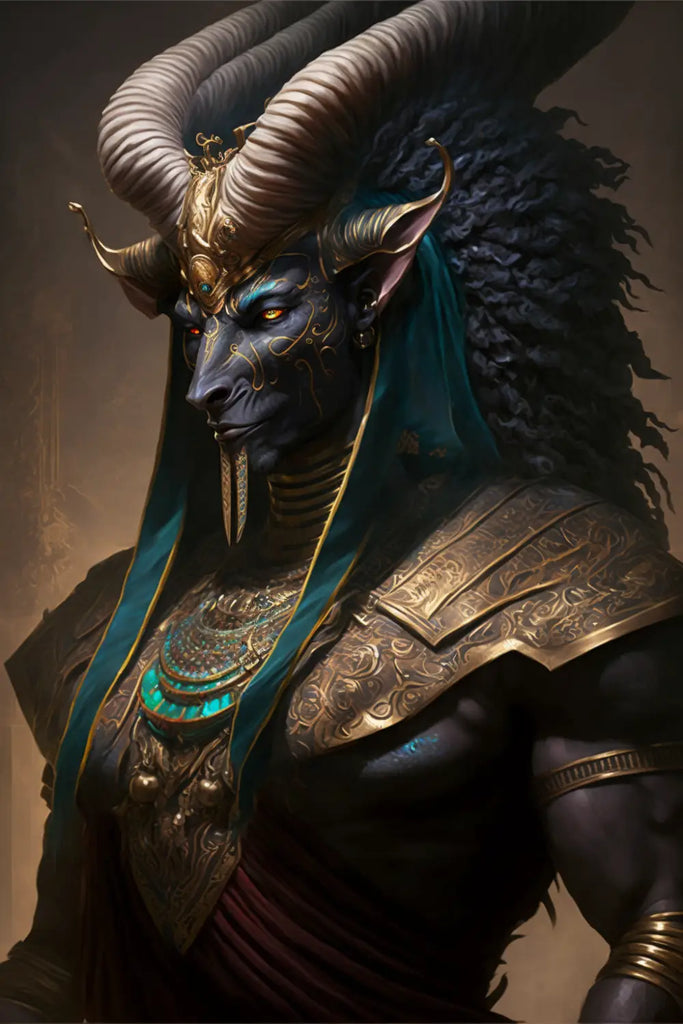Once upon a time in ancient Egypt, the mighty Nile River flowed peacefully, providing sustenance and life to the people and the land. Farmers tended to their crops, merchants peddled their wares, and the pharaoh ruled with wisdom and grace. The gods looked down upon Egypt, pleased with the harmony and prosperity they saw.
The great god Amun, known as the King of the Gods and the Lord of the Winds, watched over the land with a protective gaze. He was the embodiment of the hidden, mysterious force that guided the universe, responsible for the creation and sustenance of life itself.
But one fateful year, the skies darkened, and the rains poured down with unprecedented ferocity. The Nile, the lifeblood of Egypt, began to swell, threatening to unleash a devastating flood that would wash away the fertile lands and the people who depended on them. Fear and despair gripped the hearts of the Egyptians as they watched their homes, their crops, and their livelihoods face imminent destruction.

Amun, seeing the desperation of his people, knew that he must act to save them from the impending disaster. He summoned the other gods, calling forth Geb, the god of the Earth; Tefnut, the goddess of moisture; and Shu, the god of air, to join him in devising a plan to protect Egypt from the wrath of the raging Nile.
The gods gathered in the divine council, where they debated and discussed their options. Geb proposed raising the earth itself to provide a barrier against the floodwaters. Tefnut suggested calling upon the desert winds to dry up the excess water. Shu offered to use his mastery of the air to carry the people of Egypt to safety.
But Amun, the wisest and most powerful of the gods, had a different plan. He knew that the floodwaters could not be stopped, nor could the people of Egypt be relocated. The solution, he believed, lay in harnessing the very force that threatened to destroy the land: the mighty Nile itself.
Amun called forth the god Hapi, the deity of the Nile, and commanded him to channel the floodwaters into a vast, intricate network of canals and reservoirs. These new waterways would not only protect the land and people from the destructive force of the flood but also provide a source of irrigation for the parched fields and a means of transportation for the bustling trade of the Egyptian cities.
With Hapi's assistance, Amun directed the wind to guide the floodwaters into the newly constructed canals. As the water flowed into these channels, the floodwaters began to recede, and the people of Egypt watched in awe as the seemingly unstoppable force was tamed and controlled by their benevolent god.

The Egyptians labored tirelessly alongside the gods, digging channels, constructing reservoirs, and building embankments to protect their homes and fields from the raging waters. As the divine intervention unfolded, the people felt a renewed sense of hope and faith in their gods, particularly Amun, the god who had saved them from certain destruction.
When the floodwaters finally subsided, the land of Egypt was transformed. The new network of canals and reservoirs brought life to previously barren lands, allowing the people to cultivate even more crops and support a growing population. Trade and commerce flourished, as the waterways provided efficient means of transportation and connected cities throughout the kingdom.
The pharaoh, grateful for the salvation of his people and his kingdom, decreed that a magnificent temple be built in honor of Amun, the god who had saved Egypt from the wrath of the Nile. The temple was to be constructed at Karnak, a site chosen for its
proximity to the life-giving waters of the Nile. It would stand as a testament to the power and benevolence of Amun, and as a reminder of the divine intervention that had saved the land and its people from catastrophe.
The construction of the temple was a monumental undertaking, with thousands of laborers, artisans, and architects working tirelessly to create a monument worthy of the god who had saved them. The temple walls were adorned with intricate carvings and hieroglyphs, depicting the story of Amun's divine intervention and the gratefulness of the Egyptian people. The grand hall was lined with massive stone columns, reaching towards the heavens, symbolizing the connection between the earthly realm and the divine.
As the temple at Karnak neared completion, a grand festival was planned to celebrate its dedication. The people of Egypt, from all walks of life, gathered to pay homage to Amun and to give thanks for the salvation of their land. The air was filled with the scent of incense and the sound of music, as priests performed rituals and offered sacrifices to the god who had saved them from the devastating flood.
The festival lasted for days, with feasting, dancing, and rejoicing filling the streets of Egypt. It was a time of joy and celebration, as the people came together to give thanks and honor the god who had saved their homes, their crops, and their lives from the fury of the Nile.
From that day forward, the people of Egypt would never forget the power and the mercy of Amun, the god who had harnessed the mighty Nile and saved their land from destruction. The temple at Karnak stood as a testament to his divine intervention, a symbol of the eternal bond between the gods and the people they protected.
And so, the legend of Amun's divine intervention continues to be passed down through the generations, a reminder of the power of the gods and the resilience of the Egyptian people in the face of adversity. The tale of how the god of the winds saved Egypt from a catastrophic flood has become an enduring story of faith, hope, and the triumph of divine wisdom over chaos and destruction.
















